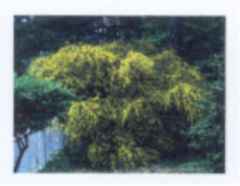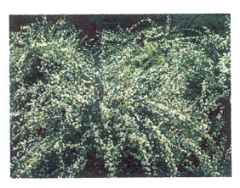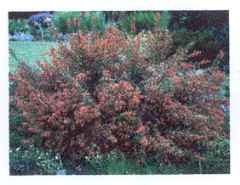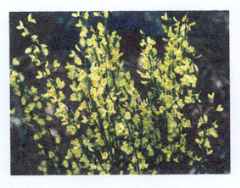 |
 |
 |
 |
 |
 |
 |
 |
Scotch Broom...Easy To Grow Beauty
Scotch broom (Cytisus scoparius) is a durable legume shrub use for dry areas to add a little color to the landscape. A friend of mine once referred to Scotch Broom as "a plant that will grow on a doorknob". We discussed "legumes" in my green pea column last month, explaining their ability to gather nitrogen from the atmosphere. This means legumes have low nutrient needs because they acquire their own food. "Brooms" are also not sensitive pH. About all they require is good drainage, thus they make a good plant for hillsides.
Most Scotch Brooms grow to a height of 4 to 6 feet, with leaves which resembles stems more than foliage. Their pea like blooms include colors of vivid yellow, pale yellow, white, and deep maroon, dependent upon which variety you plant. Bloom time ranges from late March to early June. Scotch broom will last for many years, though it can become a bit "ratty" after some years. Since broom blooms on old wood (previous season's growth), you should only prune immediately following bloom. For ratty plants, whack them to the ground after bloom for rejuvenation.
The four varieties we are carrying this year are "Moonlight", "Lena", "Nova Scotia", and Zeelandia". "Moonlight is an early bloomer which is a creamy pale yellow with fragrance, blooming from late March through April. "Lena" is a ruby red bloom which grows 3 to 4 feet tall and blooms from mid April to late May. "Nova Scotia" and "Zeelandia also bloom from mid April through late May, with "Nova Scotia" bearing brilliant yellow flowers and "Zeelandia" bearing pale lilac pink flowers. The common Scotch Broom is known for bright yellow flowers, whereas our varieties deviate from the norm.
Scotch Broom reproduces from seed and is often listed as an invasive weed, though it is not usually a problem to the home gardener. The Broom is an excellent plant for dry areas where low maintenance is desired. It is hardy from Zones 5 to 8, which means it will not perform in the deep South. This colorful accent plant is well worth considering in you landscape. Sorry - no corny jokes this week. Lucky for you readers! Until next week.
Andy Lynn